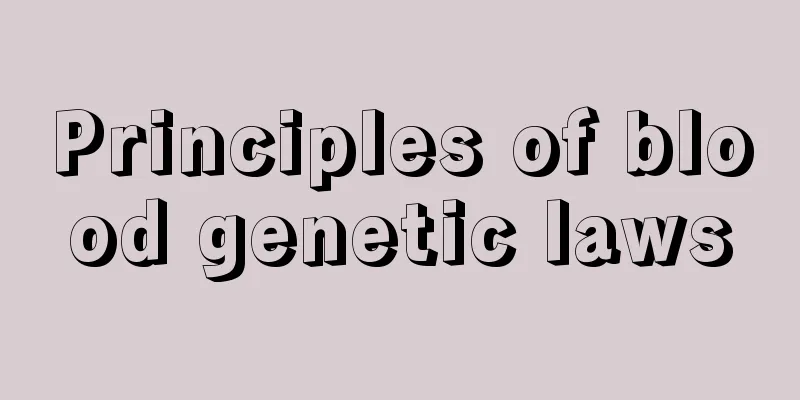Principles of blood genetic laws

|
Many of us may look like our parents. This situation occurs more frequently among our friends. In fact, this is caused by the laws of genetics. There are many laws of genetics, one of which is the law of blood genetics. The law of blood genetics can show our physiological genetics. Maybe everyone is particularly interested in the law of blood genetics, but does not know much about it. Let us learn about the law of blood genetics together. principle: 1. If the alleles on the chromosomes of somatic cells come from both parents, they are called homozygous (for example, some A-type chromosomes have alleles A and A); if the gene content contained is different, it is called heterozygous (for example, some A-type human chromosomes have alleles A and O). In other words, each individual has two and only two alleles at a certain locus, one allele from each parent. If the genes from both parents are identical, the individual is called homozygous; if they are different, the individual is called heterozygous. Whether homozygous or heterozygous, the sum of genes on a pair of chromosomes is called the genetic type. For example, the genetic types of the two people mentioned above are AA and AO respectively. However, not all inherited genes will be expressed. The traits that can be expressed are called expressions. Regardless of whether the genetics is AA or AO, the expression is A, which is what we usually call type A. It can be seen that blood type actually refers to its form of expression. The reason why the expression and inheritance of blood type are different is that some genes can express the traits they control regardless of whether they are homozygous or heterozygous. This gene is called a dominant gene. If the traits controlled by this gene are only expressed when it is homozygous but not when it is heterozygous, this gene is called a recessive gene. In the ABO blood group system, the A and B genes are dominant genes, while the O gene is a recessive gene. For example, in a pair of chromosomes, one chromosome carries the A gene and the other carries the O gene. The person's genetic formula is AO, but the expression formula is A, that is, type A, not type O. O blood type can only be expressed if both chromosomes carry the O gene. 2. Blood type refers specifically to the differences in red blood cell antigens between individuals; but it is now known that in addition to red blood cells, there are also antigen differences between individuals in white blood cells, platelets and even certain plasma proteins. Therefore, the broad definition of blood type should include the differences in antigens of each blood component among individuals. Usually, people's understanding of blood types is often limited to ABO blood types and blood transfusion issues. In fact, blood types have broad practical value in disciplines such as anthropology, genetics, forensic medicine, and clinical medicine. Therefore, they have important theoretical and practical significance. At the same time, the discovery of animal blood types has also provided new issues and research directions for blood type research. Blood types are generally divided into four types: A, B, AB and O. In addition, there are more than 10 extremely rare blood type systems, including Rh negative blood type, MNSSU blood type, P blood type, and D deletion blood type. Among them, type AB can accept blood transfusions from any blood type, so it is called a universal blood recipient. Type O can donate blood to people with any blood type, so it is called a universal blood donor or a heterogenic blood donor. In fact, blood can only be transferred in small quantities between different blood types, not in large quantities. If a large amount of blood is to be transfused, it is best to do so between people of the same blood type. The above content introduces us to the laws of blood inheritance. We know that many conditions are likely to be inherited, which provides us with selection criteria for choosing a spouse. At the same time, we can also effectively make genetic changes based on our own blood laws. We can all have a healthy body. I hope the above content is helpful to everyone. |
<<: Treatment and prevention of high blood uric acid
>>: What are the self-treatment methods for thoracic spondylosis
Recommend
Is sore throat contagious?
Sore throat is a problem that many people have an...
Do you have to lie flat if you have hip effusion?
There is no need to lie flat when there is hip ef...
Treat colorectal cancer with medicinal food
Intestinal cancer causes physical and mental pain...
What happens if you dye your hair too much?
Young people nowadays tend to pursue individualit...
What are the tools for cleaning the mouth
With the development of society, people are makin...
What to do if pimples appear on face after eating shrimp
Shrimp is a food high in protein. Many people lik...
Can silver cure rheumatism?
Rheumatism is a very painful disease. It can caus...
How to prevent and treat hamartoma
I believe most people have never heard of hamarto...
How to make delicious chicken thighs
Fungi are natural plants. Of course, as people le...
Is lung cancer contagious?
Lung cancer is a non-infectious disease that cann...
What harm does body lotion do to people
In daily life, many women buy various skin care p...
What bra should I wear for sagging breasts
If a woman's breasts sag, it will look a litt...
Bladder cancer patients may also experience bladder irritation symptoms
Bladder cancer patients may also experience bladd...
Is Kalanchoe poisonous?
Kalanchoe is native to Africa and likes a humid e...
What are the effects and functions of blue chalcedony?
Because of its different composition, chalcedony ...









